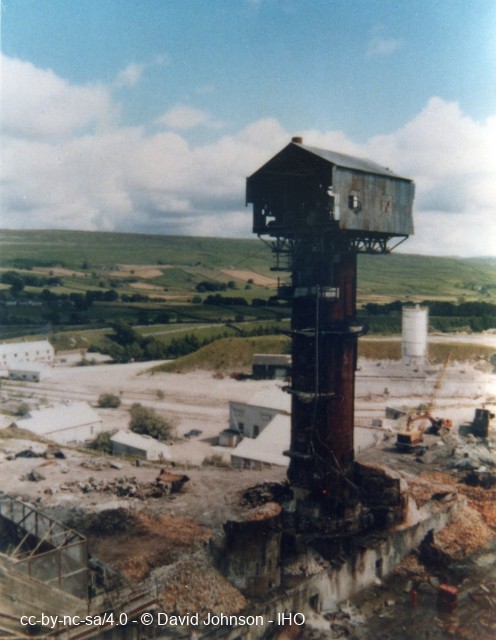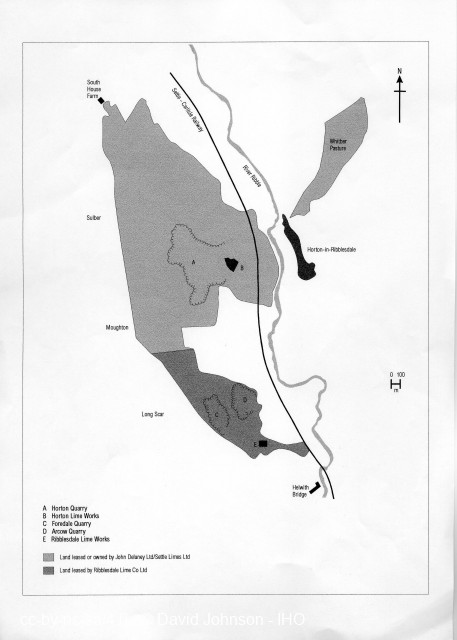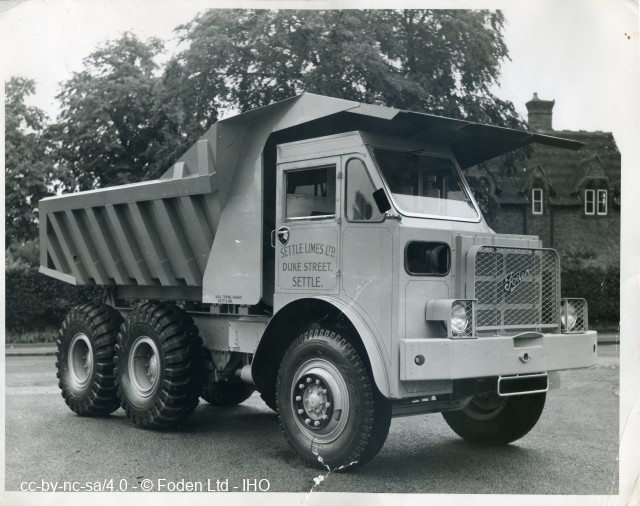Description and History of Site:-
This is a massive quarry extending c. 850m along the contours north-south by 850m east -west and it is worked on a series of benches with an early, now water-filled, quarry hole cut down well below the current base to exploit pre-Carboniferous strata - Silurian beds that the quarrymen called 'granite'. As the decades have passed, working has moved ever westwards and then downwards. It has had various lime kiln batteries in the past but any trace of those has long since been removed, along with the tar-coating plant and rail link. Today, the quarry has modern crushing and screening plant and produces mainly high-grade aggregate. The quarry as such - originally called Beecroft Quarry and Horton Lime Works- was opened up in 1888 by local entrepreneur John Delaney, eventually trading as John Delaney (Horton Limeworks) Ltd. The first workings were small scale and almost Heath-Robinsonesque with a steep incline taking skips of stone down to a small crushing plant powered by a traction engine and then wheelbarrows to transfer crushed stone to the two masonry lime kilns he erected. Production slowly increased and he despatched burnt lime and crushed stone out using his own fleet of rail wagons bringing back coal from collieries in the West Riding coalfield, for several of which he was appointed factor or agent. In 1911, the quarry performed what was described at the time as the biggest blast ever in Yorkshire using the newly-introduced ammonal grain explosive. By 1914 his complex had an internal railway and tramway system, a very steep endless-rope inclined plane from the Granite Hole, five lime kilns of the Spencer 1900 patent plus his two earlier ones, and extensive processing plant which included tar-coating plant and concrete-block plant. During WWI the Granite Hole was mothballed as demand for lime and crushed stone was so great he had to concentrate his resources there.He died in 1921 but the business continued.
In 1925 the company bought out the lease on the land they worked and owned, and new plant was erected to boost output and efficiency. In the late 1930s the Granite Hole was closed down, in 1943-44 breakers and fillers were replaced by steam shovels, peckers and motor dumpers and output almost doubled in 1947-48 and in 1949 a new Priest-Knibbs kiln was erected, only the second to be built in this country. In 1954 two massive gas-fired P-K kilns were built and two more in 1960 when two of the Spencer kilns were taken down and the others mothballed. It employed 110 men in the 1960s and was seen as one of the North's most efficient and largest limestone quarries.
John Delaney (Horton Limeworks) Ltd was subsumed within Settle Limes Ltd, when several local quarries merged operations in 1939; in 1962 the company was taken over by ICI Mond as a wholly-owned subsidiary, fully merged into ICI Mond in 1970. Ten years later ICI put it on the market: by now the workforce stood at 63.
It is currently (2018) operated by Hanson.
Further Reading and References:-Johnson, D. Limestone industries of the Yorkshire Dales. Amberley, 2010, pp. 129, 154-7, 194, 207, 212-13, 217, 219, 221, 224, 226-27, 234, 237, 243-44.
JOhnson, D. Quarrying in the Yorkshire Pennines. Amberley, 2016, pp. 27, 67, 70, 83, 86, 88, 91.
Help us improve this entry
The compilers welcome corrections or additional information on all sites.
Any information provided will be verified before appearing on the web site.
Email comments
Key Words :- operational limestone quarry
Viewing the Site :- visible from roads within the village and from local footpaths. No public access within the quarry.
Address :- Horton in Ribblesdale, Settle, North Yorkshire, BD24
Grid Ref :- SD 798 722
Co-ordinates :- Lat 54.145228 , Long -2.310728
Local Authority :- Craven District Council
Pre 1974 County :- Yorkshire - West Riding
Site Status :- Site extant - Protected status unknown
Site Condition :- Operational site, in use for original purpose
Site Dates :- 1888 - still operational
Record Date :- 12 January 2018
Copyright :- cc-by-nc-sa 4.0 © David Johnson
Grid Ref :- SD 798 722
Co-ordinates :- Lat 54.145228 , Long -2.310728
Local Authority :- Craven District Council
Pre 1974 County :- Yorkshire - West Riding
Site Status :- Site extant - Protected status unknown
Site Condition :- Operational site, in use for original purpose
Site Dates :- 1888 - still operational
Record Date :- 12 January 2018
Copyright :- cc-by-nc-sa 4.0 © David Johnson


